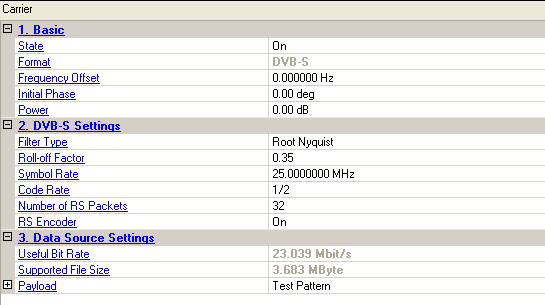
DVB-S (EN 300421) DVB-DSNG (EN 301210, Digital video for Satellite News Gathering): are first generation satellite communication system. The Symbol rates vary from 4 ksps to 60 Msps, DVB-S using QPSK modulation while DVB-DNSG using 8PSK and 16 QAM modulation.

Multi-path Channel (not shown above) is a new parameter under 2. DVB-S Settings.
Double-click or use the drop-down menu to control the operating state of the carrier.
The format of the carrier.
Range: -40.0 to 40.0 MHz
Default: 0.000000 Hz
Set the frequency offset for the carrier relative to the signal generator’s frequency setting. The valid range will be different for every format due to the different over-sampling ratios.
For example, for 2 carriers configuration, set the center frequency of signal generator to 1 GHz, and make the two carriers distributed on the both sides of the center frequency with 5 MHz offset each. Therefore, the actual frequency of each carrier would be 1GHz+5MHz and 1GHz-5MHz respectively.
Range: 0 to 359 degrees
Set the initial phase of the carrier.
Range: -50 to 0 dB
Set the carrier’s power relative to the signal generator’s amplitude setting.
The System shall employ conventional Gray-coded QPSK modulation with absolute mapping (no differential coding).
Choice: Nyquist \Root Nyquist
Default: Root Nyquist
Double-click or use the drop-down menu to select the filter type of DVB-S.
Range: 0 to 1
Default: 0.35
Set the roll-off factor of DVB-S.
Range: 300 KHz to 50MHz
Default: 25MHz
Set the symbol rate of DVB-S.
Choice: 1/2 | 2/3 | 3/4 | 5/6 | 7/8
Default: 1/2
Double-click or use the drop-down menu to select the code rate of DVB-S.
Range: 32 to 160000
Default: 32
Set the number of RS Packets. The entered value will be automatically set to the nearest reasonable value for DVB-S.
Double-click or use the drop-down menu to enable or disable the RS encoder. For DVB-S, when the RS encoder is off, the payload is treated as the output of a RS encoder and fed into the convolutional interleaver directly.
Default: OFF
Click
in the right side of the cell to open the
![]() Multi-path Channel
configuration window.
Multi-path Channel
configuration window.
A multi-path channel which contains up to 20 paths can be set according to your test requirements.
The useful bit rate. The bit rate can be transmitted by current encoding, modulation and framing configurations.
The supported file size for current settings.
The TS payload settings.
Choice:
Normal: Test Pattern | Demo File | TS File | TS File Wizard
When RS Encoder is off: Test Pattern | TS File
For DVB-H: Test Pattern | TS File
For one-seg ISDB-T: Test Pattern | TS File | TS File Wizard
Default: Test Pattern
Double-click or use the drop-down menu to select which type to be used as the data source.
If "TS File" is selected, "File Name" is required; If "TS File Wizard" is selected, "File Wizard" is available.
Learn more about the different Data Source Types, refer to the page Data Source Type.
The data bits used as test pattern.
Click the right button to open "Test Pattern Edit" dialog and select test pattern to use.
Choice: True | False
Default: False
Double-click or use the drop-down menu to determine whether a SYNC byte (0x47) should be inserted into the test pattern.